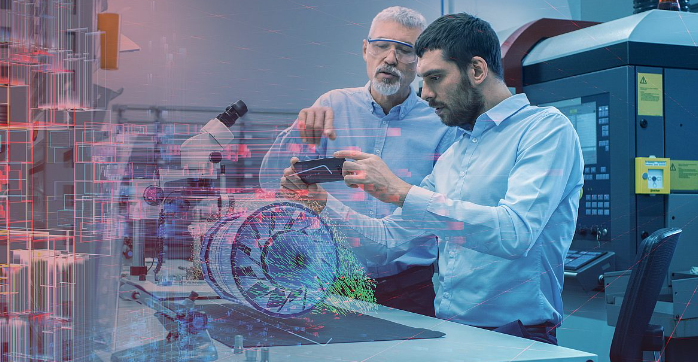Introduction: A New Frontier in Manufacturing
Extended reality (XR) is a burgeoning technology comprising virtual reality (VR), augmented reality (AR), and mixed reality (MR). How could the manufacturing sector utilize extended reality? The answer lies in the myriad applications of XR that are poised to redefine the traditional manufacturing landscape.
Benefits of Extended Reality in Manufacturing

Enhancing Productivity with Extended Reality
XR allows manufacturers to visualize complex designs, simulate real-world scenarios, and perform remote maintenance. These applications streamline production processes and enhance efficiency, positioning XR as an essential tool in modern manufacturing.
Extended Reality in Product Design and Prototyping
The ability to create 3D visualizations and virtual prototypes enables designers to iterate rapidly, reducing development costs and accelerating time-to-market. Virtual prototyping fosters collaboration, innovation, and creative exploration.
Improving Safety with Augmented Reality in Manufacturing
AR can overlay vital safety information directly onto machinery and equipment, providing real-time guidance to operators. This results in safer work environments and enables immediate response to potential hazards.
XR Maintenance Solutions for Manufacturing
XR facilitates remote troubleshooting and maintenance, allowing experts to guide onsite personnel through complex tasks without being physically present. This reduces downtime and ensures consistent operational performance.
XR Training in the Manufacturing Industry
Immersive training environments can be created using XR, helping workers develop essential skills in a risk-free setting. This not only improves workforce competence but also instills confidence, fostering a culture of excellence.
Industry 4.0 and Extended Reality
In the context of Industry 4.0, XR serves as a driving force behind the convergence of the digital and physical worlds. Its ability to bridge this gap presents endless opportunities for integration and innovation.
Extended Reality in Supply Chain and Logistics
From warehouse optimization to real-time tracking, XR offers transformative potential in supply chain management. It provides greater visibility and control, ensuring streamlined operations and increased profitability.
Future of Manufacturing with Extended Reality

The adoption of XR is not merely a trend; it’s an essential step toward a more agile, efficient, and responsive manufacturing industry. As technology evolves, the opportunities for growth and innovation are boundless.
XR Solutions for Manufacturing: A Closer Look

1. Augmented Reality in the Manufacturing Industry: Revolutionizing Workflows
AR overlays digital information onto the physical world, enabling real-time interaction with both digital and physical elements. In manufacturing, this leads to:
Real-time Data Analytics
Engineers and operators can access real-time data on machine performance, status, and other vital statistics. This data-driven approach ensures optimal performance and quick response to issues.
Remote Assistance
Experts from around the world can assist local technicians through AR, offering guidance, and even demonstrating procedures through shared AR experiences. This accelerates problem-solving and brings global expertise to local sites.
2. Virtual Reality Applications in Manufacturing: Immersive Experiences
VR creates an immersive virtual environment, completely disconnected from the real world. Applications in manufacturing include:
Virtual Showrooms
Manufacturers can create virtual showrooms to showcase their products to potential clients. This not only saves costs but offers a unique, engaging experience for customers.
Enhanced Collaboration
Design teams across different locations can collaborate in a shared virtual space, working on 3D models and prototypes, ensuring seamless integration and communication.
3. Mixed Reality: Bridging Virtual and Physical Worlds
Mixed reality combines aspects of AR and VR to create a new environment where physical and digital objects co-exist. This technology provides:
Interactive Prototyping
Designers can interact with virtual prototypes as though they were physical objects, manipulating them and observing how they react to real-world conditions.
On-the-Fly Adjustments
Factory layouts can be virtually manipulated and adjusted, allowing for efficient planning and reconfiguration without physical effort or downtime.
Challenges of Implementing XR Solutions in the Manufacturing Sector

Though promising, XR implementation does come with challenges, such as:
- Technological adaptation and integration with existing systems.
- High initial costs for top-tier systems.
- Potential resistance from workforce unused to the technology.
- Ensuring security and compliance with regulatory requirements.
The Economic Perspective: ROI and Cost-Effectiveness
Investment in XR technology can be significant, but the benefits often outweigh the costs. These include:
- Reduction in design and development time.
- Minimized errors and rework.
- Enhanced safety and training capabilities.
- Improved customer engagement and sales.
Latest Advancements in Extended Reality for the Manufacturing Industry

The rapid evolution of XR technologies continues to unveil new possibilities:
- Advanced Haptics: Providing tactile feedback for a more realistic experience.
- AI Integration: Leveraging artificial intelligence to enhance XR experiences.
- Cloud-based Solutions: Offering scalable, flexible solutions for various manufacturing needs.
Frequently Asked Questions About How Could the Manufacturing Sector Utilize Extended Reality?
Are there any cost-effective ways for small manufacturers to adopt XR technologies?
Yes, with scalable solutions and customizable platforms, small manufacturers can harness the benefits of XR without excessive expenditure.
How can extended reality help in improving product quality and reducing defects?
XR enables detailed visualization, simulation, and real-time monitoring, helping in identifying potential defects and ensuring quality control.
What is the ROI (Return on Investment) of implementing extended reality in manufacturing?
ROI varies but often includes improved efficiency, reduced costs, enhanced safety, and increased innovation potential. Many businesses find the investment in XR technology well justified.
Also Read: Beautiful Short Gown Styles [2023]
Conclusion: Shaping the Future Together
Extended reality is more than a technological advancement; it’s a catalyst for transforming manufacturing into a more agile, responsive, and innovative sector. From small businesses to large corporations, XR offers opportunities to enhance various facets of manufacturing. The journey has only just begun, and the future is filled with endless possibilities.
Concluding our analysis of “How Could the Manufacturing Sector Utilize Extended Reality?” we hope that this article has acted as a definitive resource, providing you with clarity and enabling you to make well-informed choices.

